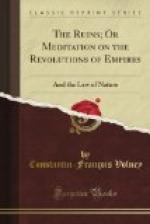to exist, to be, and signifies existing: in other
words, the principle of life, the mover or even motion
(the universal soul of beings). Now what
is Jupiter? Let us hear the Greeks and
Latins explain their theology. “The Egyptians,”
says Diodorus, after Manatho, priest of Memphis, “in
giving names to the five elements, called spirit, or
ether, You-piter, on account of the true meaning
of that word: for spirit is the source of
life, author of the vital principle in animals;
and for this reason they considered him as the
father, the generator of beings.” For the
same reason Homer says, father, and king of men
and gods. (Diod. lib. 1, sect 1).
“Theologians,” says Macrobius, “consider You-piter as the soul of the world.” Hence the words of Virgil: " Muses let us begin with You-piter; the world is full of You-piter.” (Somn. Scrip., ch. 17). And in the Saturnalia, he says, “Jupiter is the sun himself.” It was this also which made Virgil say, “The spirit nourishes the life (of beings), and the soul diffused through the vast members (of the universe), agitates the whole mass, and forms but one immense body.”
“Ioupiter,” says the ancient verses of the Orphic sect, which originated in Egypt; verses collected by Onomacritus in the days of Pisistratus, “Ioupiter, represented with the thunder in his hand, is the beginning, origin, end, and middle of all things: a single and universal power, he governs every thing; heaven, earth, fire, water, the elements, day, and night. These are what constitute his immense body: his eyes are the sun and moon: he is space and eternity: in fine,” adds Porphyry. “Jupiter is the world, the universe, that which constitutes the essence and life of all beings. Now,” continues the same author, “as philosophers differed in opinion respecting the nature and constituent parts of this god, and as they could invent no figure that should represent all his attributes, they painted him in the form of a man. He is in a sitting posture, in allusion to his immutable essence; the upper part of his body is uncovered, because it is in the upper regions of the universe (the stars) that he most conspicuously displays himself. He is covered from the waist downwards, because respecting terrestrial things he is more secret and concealed. He holds a scepter in his left hand, because on the left side is the heart, and the heart is the seat of the understanding, which, (in human beings) regulates every action.” Euseb. Proeper. Evang., p 100.
The following passage
of the geographer and philosopher,
Strabo, removes every
doubt as to the identity of the ideas
of Moses and those of
the heathen theologians.




